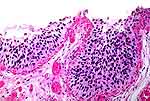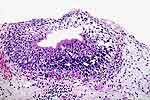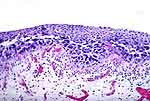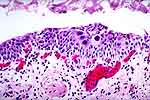 |
Figure 1: Carcinoma in-situ. The nuclei are
dark-staining and they vary markedly in their size and shape and involve
the full thickness of the epithelium. |
 |
Figure 2: Carcinoma in-situ involving
surface(left) and a von Brunn nest (right). This was photographed at the
same magnification as Figure 1, and one can see that cellular anaplasia is
less extreme, but the same comment about nuclear morphology is applicable.
|
 |
Figure 3: Carcinoma in-situ involving a von Brunn
nest. The anaplastic nuclear characteristics described in Figure 1 and
Figure 2 involve only a part of this nest. |
 |
Figure 4: Carcinoma in-situ. Only the lower half
of the epithelium is involved. |
 |
Figure 5: The pagetoid type of carcinoma in-situ.
Malignant cells (highlighted) appear to be invading through an epithelium
that is otherwise normal. |
 |
Figure 6: A few cells with malignant nuclear
features (large, dark, varied size and scant cytoplasm) remain attached to
the basement membrane (arrows): the "clinging" type of carcinoma in-situ.
|

